I rocketed into Cusco with all the energy I could muster. Fueled by the
steep descent that led me down from the ridgetop town of Anta, my entrance to
Cusco was a blur of brick buildings, colonial churches, and ice cream vendors.
This was my victory lap; reward for days of slogging along uphill, rocky,
potholed, dirt roads, and I was going to take it for all it was worth.
It didn't last long, however. As quickly as it had started, my joy ride
came to an end with a deafening thunk. The smooth pavement of the approach had
been replaced by the street worn slabs of concrete of the city roads. My rear
tire slapped into a step between a set of slabs, and my wheel immediately
began to whine in protest. I slammed on the brakes and brought the bike to a
stop, squandering all of my hard earned speed in a fraction of a second. I
pushed the bike over to the sidewalk, where I did an emergency truing job. I
continued my entrance at a much less exciting pace.
The tension in town was palpable, as the chants of crowds could be heard
from all quarters. It was a critical moment in Peruvian politics. The
elections were only a few days away, and the Peruvian election board had just
rejected the opposition candidate's request to move the election date. This
was the runoff election between Alberto Fujimori, the longtime incumbent, and
Alejandro Toledo, the political upstart who came from working class Peruvian
farming roots. By all accounts except Fujimori's, the first round of elections
was fraudulent. Once an independent body had ruled that there were signs of
possible fraud in the runoff, Toledo pulled out and called for the elections to
be delayed until the irregularities could be addressed.
News of the decision sent thousands of people to the streets in protest all
over Perú. Never one to miss a good protest, I circled around town, trying to
home in on the din coming from the crowd. I managed to reach them at the same
time that the riot police did, and they quickly formed a wall to shore up the
flood of protesters. Moments later, a wayward group that was trying to join
the main protest arrived from the other direction, but they were cut off a
block away by another wall of police. And there I was, stuck in the
demilitarized zone between the two, with no way out. I left my bike on the
street, calculating that the police lines would hold and that the oasis of
peace and quiet in which it was parked would not be overrun by angry
protesters.
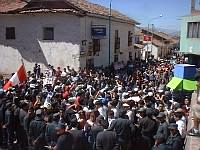 I threw a handful of lenses into the pockets in the back of my cycling
jersey, and started to scale the stone wall which lined the street. I worked
myself over to the corner, right above the teeming masses, and started
snapping away. Protesters started hamming it up for the camera as I scanned
the crowd for the perfect iconic image of the rage of the moment. Every once
in a while, things would get heated, and the riot police would whip out their
billy clubs in preparation for an attack, but only minor skirmishes erupted.
The awkward tension would occasionally be broken by the sounds of ice cream
vendors pushing thier way through the crowd. I was glad to see that they
realized that ice cream is a necessity on all occasions, not merely a luxury
saved for moments of calm.
I threw a handful of lenses into the pockets in the back of my cycling
jersey, and started to scale the stone wall which lined the street. I worked
myself over to the corner, right above the teeming masses, and started
snapping away. Protesters started hamming it up for the camera as I scanned
the crowd for the perfect iconic image of the rage of the moment. Every once
in a while, things would get heated, and the riot police would whip out their
billy clubs in preparation for an attack, but only minor skirmishes erupted.
The awkward tension would occasionally be broken by the sounds of ice cream
vendors pushing thier way through the crowd. I was glad to see that they
realized that ice cream is a necessity on all occasions, not merely a luxury
saved for moments of calm.
After shooting a full roll of film, I headed back to the ground. I bought
an ice cream and started making friends with a few people who were also caught
in the DMZ. One was a lady from a nearby village, who had brought her old
splintered cookspoon and battered pot to symbolize the financial plight of the
villagers. She was not alone. The crowd was filled with little old ladies
you'd expect to see in a bingo parlor, not protesting in the streets,
screaming at the top of their lungs.
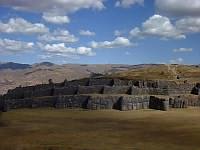 My ice cream consumed, I figured it was time to break through the crowds and
start looking for a hostel. Things had calmed down considerably, and as I
approached the police line in front of the smaller of the crowds, they parted,
leaving me a nice passageway through the crowd to the empty streets beyond.
My ice cream consumed, I figured it was time to break through the crowds and
start looking for a hostel. Things had calmed down considerably, and as I
approached the police line in front of the smaller of the crowds, they parted,
leaving me a nice passageway through the crowd to the empty streets beyond.
Cusco is the capital of the Incan state of Cuzco. Rich with such colonial
treasures as the churches of Santo Domingo and San Francisco, it was also
ground zero for travelers in Perú. Nearly everyone who visits Perú ends up in
Cusco at least once, often for weeks at a time. No longer the novelty I was in
the country, I soon faded into the mob of tourists that were awash in the main
plaza.
I moved into an area that could rightfully be called "Little Israel," from
the huge population of Israeli tourists that had taken over. As it would turn
out, much of South America had been overrun by rude, drunken Israelis who were
celebrating the end of their military service by forming packs and partying in
the four corners of the globe. They apparently had an intricate network which
allowed them to guarantee that wherever they went, they would be surrounded by
their drunk, partying brethren. The Israeli invasion created quite a rift in
the traveling community; many would change hostels until they found an oasis
where they wouldn't be kept up until 4am. And alas, even with all of the
restaurants catering to the Israeli palate, a good bagel (or any bagel, for
that matter) could not be found (I'm told that's because it isn't really an
Israeli specialty as much as it is American Jewish.)
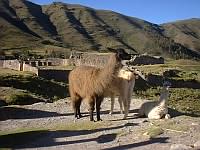 My main objective in Cusco was to walk the Inca Trail, and old Incan route
which ended at Machu Picchu, the crown jewel of the Incan Empire. But before
I began the three day trek, I wanted to check out the sights in and around
town. Biking distance from town were the Incan ruins of Sacsayhumán, Puca
Pucara, and Tambomachay. The stonework at Sacsayhumán was mindboggling - huge
boulders, five feet tall and weighing several tons each, fit together with such
precision that there was barely a 1/4" gap between them. Archeologists are
still unsure of how they managed to hew the stones with such precision.
Strangely enough, the ruins sites were the first place I saw women and
children wearing the colorful and elaborate traditional clothing - apparently
they could make good money just sitting near the ruins and being paid to have
their pictures taken. I wouldl give the kids rides on the back on my bike
while they waited for the next tourist bus to arrive.
My main objective in Cusco was to walk the Inca Trail, and old Incan route
which ended at Machu Picchu, the crown jewel of the Incan Empire. But before
I began the three day trek, I wanted to check out the sights in and around
town. Biking distance from town were the Incan ruins of Sacsayhumán, Puca
Pucara, and Tambomachay. The stonework at Sacsayhumán was mindboggling - huge
boulders, five feet tall and weighing several tons each, fit together with such
precision that there was barely a 1/4" gap between them. Archeologists are
still unsure of how they managed to hew the stones with such precision.
Strangely enough, the ruins sites were the first place I saw women and
children wearing the colorful and elaborate traditional clothing - apparently
they could make good money just sitting near the ruins and being paid to have
their pictures taken. I wouldl give the kids rides on the back on my bike
while they waited for the next tourist bus to arrive.
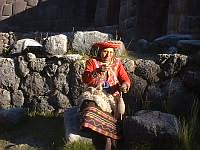 There were several ways to visit Maschu Picchu. The easy way was to hop on a
tourist train to the town of Aquas Calientes, then take the bus right to the
base of the ruins. There was also a day hike option, but the most spectacular
way to see the ruins was by walking the Inca Trail. The Inca Trail is a stone
pathway that connected the various cities of the Incan Empire. It is
believed that couriers would run from one end of the empire to the other
delivering news; the original "sneaker net," or perhaps, more accurately,
leather thong net.
There were several ways to visit Maschu Picchu. The easy way was to hop on a
tourist train to the town of Aquas Calientes, then take the bus right to the
base of the ruins. There was also a day hike option, but the most spectacular
way to see the ruins was by walking the Inca Trail. The Inca Trail is a stone
pathway that connected the various cities of the Incan Empire. It is
believed that couriers would run from one end of the empire to the other
delivering news; the original "sneaker net," or perhaps, more accurately,
leather thong net.
You could hike the trail as part of an organized tour, where they would
carry all your gear, set up your tent, even cook the meals, but I of course
opted for the solo option. I rented a stove, but decided against a warmer
sleeping bag or tent, in order to make room for all of my camera gear. I also
cut corners on the food, bringing as little as possible to get me through my
three days. Cutting out chocolate, however, was not an option.
You need to take a local trian to get to the start of the trail, but for
some reason, they segregated all of the backpackers into one car. The train
had to climb the same hill that I descended several days before, and so it
zig-zagged all the way up, creaking to a halt and switching direction every
couple of kilometers.
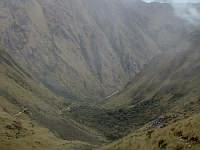 I had started alone, but before I had detrained, I had a new group of
friends. There were only a handful of us doing the hike without support, and
we all stared out together. But before too long, I found myself alone again,
absorbed in the grandeur of the mist enshrouded foothills. Along the way, I
met a fellow solo hiker named Jason, one of the very few Americans I had met
my whole trip. Jason was a writer, a free spirit, and had come to Peru as
part of a greater journey, a journey of discovery, which would also lead him to
follow the footsteps of Jack Kerouac to Big Sur, California. Jason and I
talked a lot that day, and ended up hiking together all the way to camp.
After taking several rest stops to munch on some snacks, the friends I had met
earlier caught up, and the group of eight of us continued on together.
I had started alone, but before I had detrained, I had a new group of
friends. There were only a handful of us doing the hike without support, and
we all stared out together. But before too long, I found myself alone again,
absorbed in the grandeur of the mist enshrouded foothills. Along the way, I
met a fellow solo hiker named Jason, one of the very few Americans I had met
my whole trip. Jason was a writer, a free spirit, and had come to Peru as
part of a greater journey, a journey of discovery, which would also lead him to
follow the footsteps of Jack Kerouac to Big Sur, California. Jason and I
talked a lot that day, and ended up hiking together all the way to camp.
After taking several rest stops to munch on some snacks, the friends I had met
earlier caught up, and the group of eight of us continued on together.
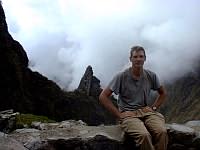 The last few hours of hiking were all uphill, and I pulled out some of the
coca leaves that I had bought in the market in Cusco to chew on while I hiked.
Chewing coca is an ago old remedy for altitude sickness. Not being
susceptible to altitude problems at 13,000 ft. and having long been
acclimated from my biking, I can't really say if it helped or not, but it sure
did a good job of numbing my mouth and helping me produce copious amounts of
green spit.
The last few hours of hiking were all uphill, and I pulled out some of the
coca leaves that I had bought in the market in Cusco to chew on while I hiked.
Chewing coca is an ago old remedy for altitude sickness. Not being
susceptible to altitude problems at 13,000 ft. and having long been
acclimated from my biking, I can't really say if it helped or not, but it sure
did a good job of numbing my mouth and helping me produce copious amounts of
green spit.
Camp eventually appeared, in the form of a small plateau, which seemed out
of place in the steep valley that we were climbing. The morning hike
continued with steep climbing, but eventually the saddle yielded to our
efforts. We were rewarded with a beautiful view into the next valley, where,
way off in the distance, we could see Runkurakay, the first of the major Incan
sites.
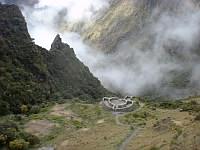 The further in we hiked, the more elaborate the ruins. I could almost imagine
what it must have been like in Incan times; people from the suburbs heading
into the city on the Inca Trail for a night on the town. Since I was doing
the trail in a day less than everyone else, I forged ahead on the second day,
arriving at the ruins of Phuyupatamarka by 4pm. I set my bivy up on the side
of a hill, with a spectacular view of the ruins below and snow capped
mountains ringing the horizon. I was above the cloudline, and as the cloud
layer streamed into the valleys below, I felt as if I were in heaven. As
darkness fell, I sat and watched the stars appear and disappear with each
passing cloud.
The further in we hiked, the more elaborate the ruins. I could almost imagine
what it must have been like in Incan times; people from the suburbs heading
into the city on the Inca Trail for a night on the town. Since I was doing
the trail in a day less than everyone else, I forged ahead on the second day,
arriving at the ruins of Phuyupatamarka by 4pm. I set my bivy up on the side
of a hill, with a spectacular view of the ruins below and snow capped
mountains ringing the horizon. I was above the cloudline, and as the cloud
layer streamed into the valleys below, I felt as if I were in heaven. As
darkness fell, I sat and watched the stars appear and disappear with each
passing cloud.
I wanted to get to Machu Picchu before the crowds, so I was up before
sunrise. A thin layer of frost had covered everything, and my water bottle
had frozed in the cold of the night. I brushed the frost off my bivy and
headed off, just as the surrounding peaks wre being bathed in the glow of the
early morning sun.
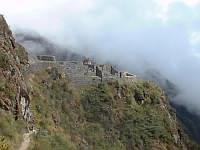 The final hike was nothing but a long, continuous set of stairs down. The
Incans must have had thighs of steel. I had consulted my topo map before
heading out and realized that there was a lesser known alternate trail to
Machu Picchu. Apparently, this alternate route was what was used prior to
the discovery of the one in use today. It approached Machu Picchu from a
more interesting direction, and it seemed like my one chance to get off the
beaten path of the main Inca Trail, so when a fork appeared in the trail, I
took it.
The final hike was nothing but a long, continuous set of stairs down. The
Incans must have had thighs of steel. I had consulted my topo map before
heading out and realized that there was a lesser known alternate trail to
Machu Picchu. Apparently, this alternate route was what was used prior to
the discovery of the one in use today. It approached Machu Picchu from a
more interesting direction, and it seemed like my one chance to get off the
beaten path of the main Inca Trail, so when a fork appeared in the trail, I
took it.
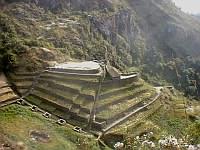 The trail was clearly less traveled, overgrown and covered with leaves, but
it was clearly a trail. About an hour in, however, the trail started
thinning, an it was soon joined by a three inch diameter water pipe. Fairly
quickly, the water pipe became the defining feature, and the trail all but
disappeared. The "trail" was cut into a steep hillside, and every fifth step
my foot would break through the leaves that I would be stepping on, and I
would sink in to my waist. I soon found myself using the water pipe to
support myself, climbing hand over hand as my feet flailed desperately for
purchase. Things got worse, and I had to resort to removing my pack and
lowering it so that I could downclimb trees. At that point, I realized that
I was not on an alterate Inca Trial, but rather the path that was used to
install the pipline, and it probably hadn't been traveled since the pipe had
been installed.
The trail was clearly less traveled, overgrown and covered with leaves, but
it was clearly a trail. About an hour in, however, the trail started
thinning, an it was soon joined by a three inch diameter water pipe. Fairly
quickly, the water pipe became the defining feature, and the trail all but
disappeared. The "trail" was cut into a steep hillside, and every fifth step
my foot would break through the leaves that I would be stepping on, and I
would sink in to my waist. I soon found myself using the water pipe to
support myself, climbing hand over hand as my feet flailed desperately for
purchase. Things got worse, and I had to resort to removing my pack and
lowering it so that I could downclimb trees. At that point, I realized that
I was not on an alterate Inca Trial, but rather the path that was used to
install the pipline, and it probably hadn't been traveled since the pipe had
been installed.
I thought about turning back, but I had already invested a couple of hours
in the route, and it was heading in the right direction.
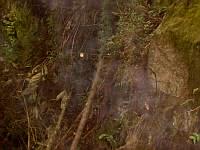 At one point, I reached a small rockface, about twelve feet across and ten
feet high. Two three inch diameter logs had been lashed together and layed
alongside the face as a makeshift "bridge." I was relieved to see any
evidence of human passage, and started inching my way along the logs.
Halfway across, an abrupt snap sent me from a state of relief to a state of
panic, as I plummetted down the face. The logs had broken clean in half, and
I found myself at the botton, in a tangle of leaves and branches. After
gathering my wits, I slowly pawed my way up the muddy wall alongside the
rock, attempting to return myself to the "trail." Moments later, I noticed
my digital camera and water bottle were missing, and I headed back to where I
had fallen. I found my camera suspended ten feet off the deck, the strap
caught on a branch. I carefully retrieved it. The waterbottle was somewhere
halfway down the mountain, so I decided to go on without it.
At one point, I reached a small rockface, about twelve feet across and ten
feet high. Two three inch diameter logs had been lashed together and layed
alongside the face as a makeshift "bridge." I was relieved to see any
evidence of human passage, and started inching my way along the logs.
Halfway across, an abrupt snap sent me from a state of relief to a state of
panic, as I plummetted down the face. The logs had broken clean in half, and
I found myself at the botton, in a tangle of leaves and branches. After
gathering my wits, I slowly pawed my way up the muddy wall alongside the
rock, attempting to return myself to the "trail." Moments later, I noticed
my digital camera and water bottle were missing, and I headed back to where I
had fallen. I found my camera suspended ten feet off the deck, the strap
caught on a branch. I carefully retrieved it. The waterbottle was somewhere
halfway down the mountain, so I decided to go on without it.
By that point, I was ready to abort the mission and head to the main
trail, but it wasn't clear that turning back was any safer than pushing on.
When a gully appeared, I took it, mostly sliding down on my butt on the wet
and muddy chute. After ten minutes of slipping and sliding, I reached the
unmistakable stone steps of the Inca Trail. I kissed the ground in
relief.
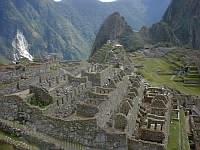 I hiked the next few hours without water, and by the time I reached the "sun
gate," the crest of the hill from where Machu Picchu could first be seen, I
was a mess. I was tired, dehydrated, and covered in mud. I collapsed on a
rock to admire the view and recover some strength, but I was soon joined by
flocks of tourists, all shiny and clean, wearing white skirts and high
heels. They had walked the 15 minutes from the lodge for the view, at the
lodge which they had arrived at without doing any more than lifting a finger
to pay the bus driver $5 to drive them from the train station.
I hiked the next few hours without water, and by the time I reached the "sun
gate," the crest of the hill from where Machu Picchu could first be seen, I
was a mess. I was tired, dehydrated, and covered in mud. I collapsed on a
rock to admire the view and recover some strength, but I was soon joined by
flocks of tourists, all shiny and clean, wearing white skirts and high
heels. They had walked the 15 minutes from the lodge for the view, at the
lodge which they had arrived at without doing any more than lifting a finger
to pay the bus driver $5 to drive them from the train station.
Machu Picchu was spectacular, delicately balanced on a saddle, terraces
spilling over the plateau down the hillside. After several hours of just
sitting and soaking it all in, I decided to figure out where the trail I had
attempted to take eventually ended up. A narrow trail snaked up behind the
ruins and headed towards an old Incan bridge. The bridge was built against a
cliff face, and the idea was that the Incans could simply remove the logs
that made up the bridge to keep invaders from passing. Unfortunately, the
next section of the bridge, which was clearly made in recent history, with
steel poles drilled into the cliff to suport a wood boardwalk, had been
ripped up to prevent passage. Apparently, someone had died on it a few years
earlier. On top of that, the trail continued across the face of a sheer
granite cliff, with only a tiny ledge to keep you from falling down the 500
ft. face. That was the trail I was heading towards. It was a good thing I
bailed when I did.
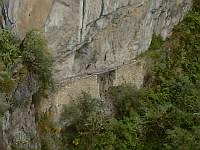 The conclusion to my trip was anti-climactic, as I paid my $5 along with
everyone else to sit on a luxury bus, which wound itself down the dusty
switchbacks to the train station, and the train slowly chugged its
way back home to Cusco.
The conclusion to my trip was anti-climactic, as I paid my $5 along with
everyone else to sit on a luxury bus, which wound itself down the dusty
switchbacks to the train station, and the train slowly chugged its
way back home to Cusco.

